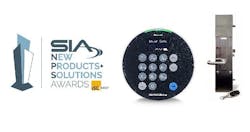Ingersoll Rand Security Technologies and The CBORD Group, Inc., are conducting the most comprehensive access control Near Field Communications (NFC) trial in the North American marketplace to date. Since November 2011, Villanova University students and staff have been using the aptiQmobile™ web-based service from Ingersoll Rand Security Technologies along with NFC and their own personal smartphones as their credential to access dormitories, academic buildings and administration offices. The NFC credential seamlessly integrates with Villanova’s CS Gold® campus card system from CBORD®.
Here's a link to Ingersoll Rand and Villanova University's video coverage of this study: http://www.youtube.com/IngersollRandST.
To enter buildings, students simply open the aptiQmobile™ app and tap their phone to the smart reader on the wall in the same way that they would present their Wildcard campus ID badge.
“Today’s students are so technologically advanced that it is second nature for them to put everything on their phones and, most of the time, it’s already in their hands while walking across campus,” explains Kathy Gallagher, Villanova director of card services. “We want to provide our students the utmost in convenience and flexibility through the technology we offer. It’s easier for students to use an app on their phone versus digging for their card.”
Three research projects were conducted among 1300 students and decision makers across 980 U.S. colleges and universities, both public and private, 2-year and 4-year, during May of 2011. Researchers found that two-thirds of American college students are interested in using their mobile phone in place of an ID card. Students feel they are less likely to lose their phone than an ID card and they know that ID cards are shared; phones aren’t. In fact, people will almost always notice that their phone is lost faster than noticing a card is missing. Using a phone as a credential also offers the ability to remotely erase credential data in case it’s lost or stolen, providing an extra layer of security. In a survey among the students in the Villanova trial, more than 70 percent stated they would prefer to use their phone instead of a badge to enter buildings.
The enhanced convenience of using smartphones instead of badges extends to administrators in charge of access control systems. Rather than having to print physical ID badges for each student at enrollment time, a mobile ‘key’ can be issued online by the administrator directly to the student’s phone at any time, saving the university staff time, administrative costs and the expense of printers, ink, card inventory and other needed supplies.
“Using smart phones as badges saves time that can be better spent on other issues,” emphasizes John Bonass, Villanova systems manager. “Assigning the credential to the students’ phone takes less work than printing and delivering a badge, and since students are very protective of their phones, this should lead to a greatly reduced replacement rate. If a phone is lost or broken, a new ID can be reissued to the new phone without even having the students come to our office.”
“CBORD is committed to providing leading technology solutions that improve the quality of university life, solving practical problems, enhancing safety and lowering costs at the same time,” commented Max Steinhardt, COO of CBORD. “In partnership with Villanova and Ingersoll Rand, this smart phone approach to the student credential is a way to make the system better support the way the university community lives and works day to day.”
“An added benefit of the aptiQmobile NFC solution is that the organization may not need to change out their locks to use it when it becomes commercially available,” adds Jeremy Earles, Ingersoll Rand Security Technologies product marketing manager, readers and credentials. “If smart-enabled AD-Series locks or XceedID smart readers are already installed, it’s simply a matter of downloading the credentialsto the students’ phones and they are ready to go. If non-smart access technology is being used, multi-technology readers can be installed to help ease into the transition by reading both the ID badges and the smartphones.”
In the United States, more than 40 million phones are expected to be NFC-enabled by the end of 2012 and according to a report by Market Research, nearly half of all mobile phones will be NFC enabled by 2016.
Supporting Research
Research from Ingersoll Rand Security Technologies has found that two-thirds of American college students are interested in using their cell phone in place of an ID card. Students feel they are less likely to lose their phone than an ID card and they know that ID cards are shared; phones aren’t. In fact, people will almost always notice that their phone is lost faster than noting a card is missing. A quick call to the phone service provider and the phone is shut off whereas an ID card could be used by another individual for some time.
Data from independent research undertaken by Ingersoll Rand Security Technologies, Effective Management of Safe & Secure Openings & Identities, also unearthed that nearly half of all students identify their cell phones as their favorite personal electronic device. Almost half of all students are already using cell phone apps to make college life easier. Campus apps include managing class work, checking grades, communicating with their professors and receiving notifications and alerts. Blackboard is the students’ most popular. They are also using apps for the bookstore, bus schedule, maps and townie discounts.
“There are a great number of early adaptors in the college population that are already sold on cell phones being a credential, just like they were sold on the use of smart cards and biometrics previously,” emphasizes Beverly Vigue, Ingersoll Rand Security Technologies vice president of education markets. “This, of course, ties in nicely with the budding discussion of NFC (near field communication) which will inevitably end up on cell phones. No Visa card; no MasterCard card…only your cell phone will be needed for cashless payments or to show your identity.”
According to Vigue, there are currently very few phones in use with this capability, but the population is growing every month and the availability of these phones, and their infrastructures, should increase dramatically over the next couple of years. Many end-users are very excited about this new technology and its future use in the marketplace.
“It is important to understand that the solution is still in the testing phase and not yet ready for mass commercialization. Plus, it is hard to determine what the phone providers will charge for having this attribute,” Vigue warns. “Nonetheless, as with the use of smart cards and biometrics, the early adaptors will be on college campuses, ready to bring the technology to the commercial market along with themselves and their degrees upon graduation.”






